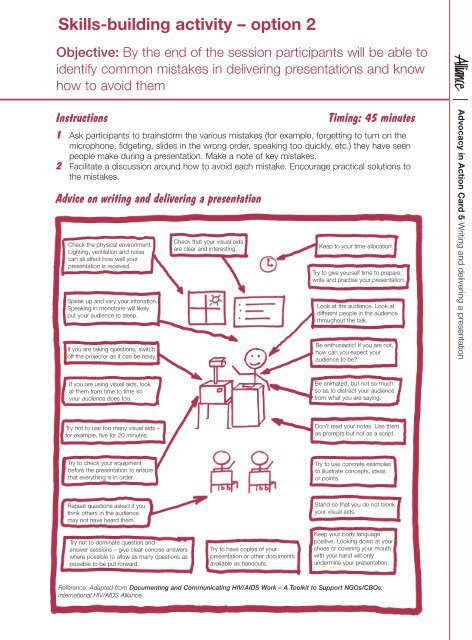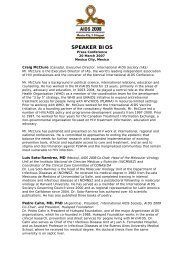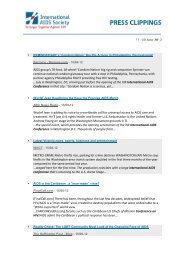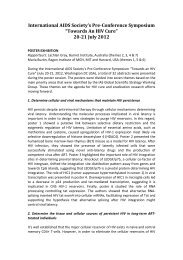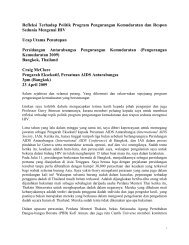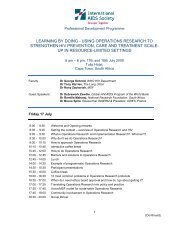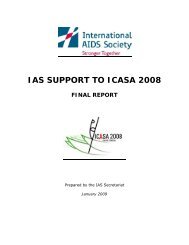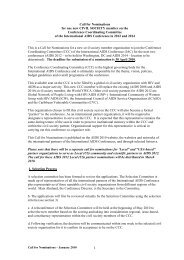Advocacy in Action - International AIDS Society
Advocacy in Action - International AIDS Society
Advocacy in Action - International AIDS Society
You also want an ePaper? Increase the reach of your titles
YUMPU automatically turns print PDFs into web optimized ePapers that Google loves.
Skills-build<strong>in</strong>g activity – option 2<br />
Objective: By the end of the session participants will be able to<br />
identify common mistakes <strong>in</strong> deliver<strong>in</strong>g presentations and know<br />
how to avoid them<br />
Instructions<br />
Tim<strong>in</strong>g: 45 m<strong>in</strong>utes<br />
1 Ask participants to bra<strong>in</strong>storm the various mistakes (for example, forgett<strong>in</strong>g to turn on the<br />
microphone, fidget<strong>in</strong>g, slides <strong>in</strong> the wrong order, speak<strong>in</strong>g too quickly, etc.) they have seen<br />
people make dur<strong>in</strong>g a presentation. Make a note of key mistakes.<br />
2 Facilitate a discussion around how to avoid each mistake. Encourage practical solutions to<br />
the mistakes.<br />
Advice on writ<strong>in</strong>g and deliver<strong>in</strong>g a presentation<br />
Check the physical environment.<br />
Light<strong>in</strong>g, ventilation and noise<br />
can all affect how well your<br />
presentation is received.<br />
Speak up and vary your <strong>in</strong>tonation.<br />
Speak<strong>in</strong>g <strong>in</strong> monotone will likely<br />
put your audience to sleep.<br />
If you are tak<strong>in</strong>g questions, switch<br />
off the projector as it can be noisy.<br />
Check that your visual aids<br />
are clear and <strong>in</strong>terest<strong>in</strong>g.<br />
Keep to your time-allocation.<br />
Try to give yourself time to prepare,<br />
write and practise your presentation.<br />
Look at the audience. Look at<br />
different people <strong>in</strong> the audience<br />
throughout the talk.<br />
Be enthusiastic! If you are not,<br />
how can you expect your<br />
audience to be?<br />
<strong>Advocacy</strong> <strong>in</strong> <strong>Action</strong> Card 5 Writ<strong>in</strong>g and deliver<strong>in</strong>g a presentation<br />
If you are us<strong>in</strong>g visual aids, look<br />
at them from time to time so<br />
your audience does too.<br />
Be animated, but not so much<br />
so as to distract your audience<br />
from what you are say<strong>in</strong>g.<br />
Try not to use too many visual aids –<br />
for example, five for 20 m<strong>in</strong>utes.<br />
Don’t read your notes. Use them<br />
as prompts but not as a script.<br />
Try to check your equipment<br />
before the presentation to ensure<br />
that everyth<strong>in</strong>g is <strong>in</strong> order.<br />
Try to use concrete examples<br />
to illustrate concepts, ideas<br />
or po<strong>in</strong>ts.<br />
Repeat questions asked if you<br />
th<strong>in</strong>k others <strong>in</strong> the audience<br />
may not have heard them.<br />
Try not to dom<strong>in</strong>ate question and<br />
answer sessions – give clear concise answers<br />
where possible to allow as many questions as<br />
possible to be put forward.<br />
Try to have copies of your<br />
presentation or other documents<br />
available as handouts.<br />
Stand so that you do not block<br />
your visual aids.<br />
Keep your body language<br />
positive. Look<strong>in</strong>g down at your<br />
shoes or cover<strong>in</strong>g your mouth<br />
with your hand will only<br />
underm<strong>in</strong>e your presentation.<br />
Reference: Adapted from Document<strong>in</strong>g and Communicat<strong>in</strong>g HIV/<strong>AIDS</strong> Work – A Toolkit to Support NGOs/CBOs,<br />
<strong>International</strong> HIV/<strong>AIDS</strong> Alliance.


